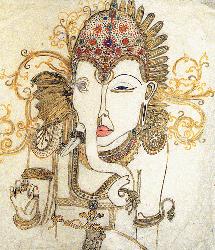 Year on the Web
Year on the Web Year on the Web
Year on the Web


Ramsay Ong is not known in Sri Lanka, although he has lived here for the past two years. The Malaysian artist who gained international recognition prefers it this way, for in the misty hills of Hantane where he now makes his home, he has found the serenity and solitude he was searching for.
Ong is 53 and a widely travelled man. Establishing himself initially as a batik artist, he gained international recognition and spent time teaching in Hawaii, Hong Kong and Australia. His batik art has been featured on a Readers Digest cover and in several newspapers and magazines. He has, however, moved on to different mediums and now works more on bark cloth and rice paper. Using bark cloth, marked a radical departure from his usual style, a period he now, in retrospect, calls his 'second development.' Bark cloth, which can even be made from the common 'Del' tree, though originally used for garments in Malaysia, was rarely used as a medium for art, being coarse and fibrous, but Ong having first seen it being used by Tongans, found it most suitable for an organic style of work.
His sojourn in Sri Lanka has led him also to seek Lankan materials and in his studio is a pile of carefully pressed 'Bo-leaves' which he plans to put to good use. "I see them all around, fallen on the ground and I think they would be wonderful in my paintings," he says. The Bo- leaves are placed on rice paper and Ong then composes his picture around this. He has also used coconut fibre, rice paper and wood bark together in his work achieving a felicitous blend of the three mediums.
Ong is not one to work to a strict schedule. Artists, creative people, he believes cannot be restricted to a time table. So one would find him quite happy to wander around Kandy, and into the depths of the jungle, making friends with people he meets and taking in the sights around him. "My friends sometimes think I'm loafing around, wasting my time" he says wryly, "but actually I'm building up a fund of ideas." Then when the time is right, he shuts himself up, and works in a torrent of energy, not even, he says, pausing for meals, until he falls asleep exhausted. Life, he adds, is meaningless, if you don't have the time to stop and stare, or in his case absorb.
For any Lankan, disillusioned with the country, the destruction of its forests, the sometimes haphazard progress of development, meeting Ong would be a tonic. For he has an infectious enthusiasm for Sri Lanka. The country's wealth, he sees, is its diversity. Not only is he buoyed by its beauty, which he terms a painter's paradise, he is equally intrigued by the people and the mix of cultures. As for the country's current problems he takes a philosophical view that there is no country without them, though he admits that his family and friends thought he was out of his mind to even contemplate moving to a place fraught with violence when he could have chosen the tranquility of Bali or even Kerala, which he says he likes almost as well.
 God
Ganesh
God
Ganesh
Ong's art is constantly evolving and in his recent work one
sees a preoccupation with Buddhist themes. He has drawn several heads of the
Buddha, capturing the serenity of countenance with delicate grace. On the walls
of his cosy home are several works that reflect aspects of Lanka. The Kandyan
dancers, the Hantane forest, God Ganesh, the elephants, anthuriums.......He
hopes to have a show in Colombo and Kandy, perhaps in the next six months or one
year if he can produce sufficient paintings within that time. At present, his
work is sent back to Malaysia, because he knows it has a ready market there.
Despite counting some thirty years as an artist, Ong is ever keen to learn and absorb something new. He comments that Sri Lankan artists he has come across too strike him as being very receptive to new ideas, which he sees as a positive sign. Again the emphasis on evolving as one goes along. He has learnt as much from his pupils as he has taught them. "If you think you are the best, you never bother about others and you never learn. That way, your art becomes static and stale and you kill yourself." It may sound dramatic, but Ong firmly believes in this.
Ong's other philosophy involves sharing his knowledge. When he was in Malaysia, he says friends would advise him against revealing 'trade secrets.' But he believes that in being generous and letting others learn his techniques he himself opens up to new ideas. Similarly, he says he has not kept his so-called 'best work' for himself. "So many people ask me why I don't keep the best paintings for myself but I believe that my best work is what I create tomorrow, tomorrow and the day after. What I have created today is not a milestone. If I think I have already done my best, then I don't give myself room for a better piece to come." If all his tomorrows could be in Sri Lanka, Ong would be well content.
Continue to Plus page 2 - It’s all about music and mime * That all important precept






Please send your comments and suggestions on this web site to
info@suntimes.is.lk or to
webmaster@infolabs.is.lk